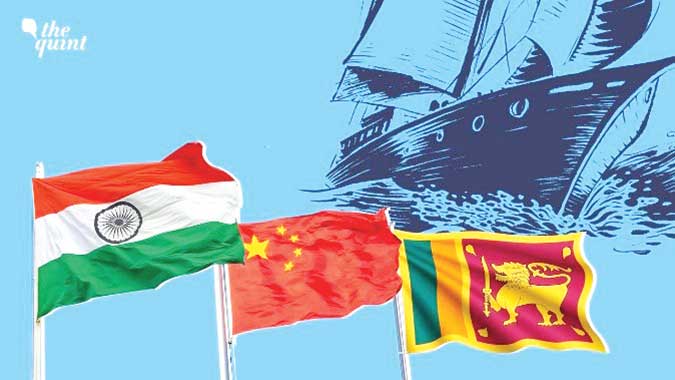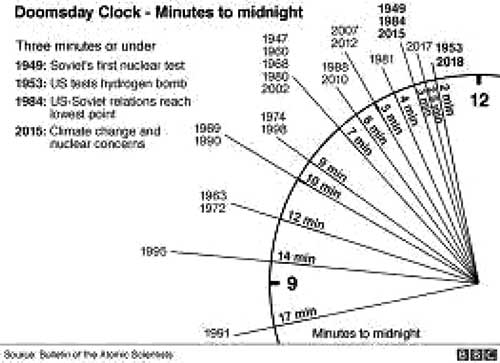Features
All align for Sri Lanka’s Debt, Tanks align in Ukraine, Doomsday Clock ticks to Midnight Hour

by Rajan Philips
Over the last two weeks Sri Lanka has been inundated with assurances of support by the world’s three most populous and powerful countries. India, America and China – all three of them marked their presence in Sri Lanka in one way or another. Japan and UK have also come on board to reinforce Sri Lanka’s pleas for IMF help. Before that on Sunday, January 8, 182 economists, social scientists and development experts, including such generational names in Economics as Jayati Ghosh, Thomas Piketty, and Yannis Varoufakis, issued a statement to the (British) Guardian that “all lenders—bilateral, multilateral, and private must share the burden of restructuring” Sri Lanka’s debt. Both were big news for Sri Lanka. A case of overwhelming global support to a rather underwhelming Sri Lankan government.
The big news for the world this week was the agreement between the US and Germany and the rest of NATO to send Germany’s Leopard 2 and America’s Abram tanks to Ukraine to fight Russia. And Russia is widening the frontiers of an emerging global cold conflict by partnering South Africa to stage joint naval exercises in African waters. There is no comparison between the situations in Sri Lanka and in Ukraine although there have been past linkages between the corrupt regimes of the two countries for private gains of the powerful. However, by all appearances and for the sake of argument while the world appears to be coming together in Sri Lanka, it is getting hopelessly divided over Ukraine. According to Doomsday Clock scientists, the war in Ukraine is triggering the gravest threat to the world since World War II.
Doomsday Clock
The Doomsday Clock was set up in 1947 by a group of atomic scientists to provide a measure of the catastrophic threats facing the planet and humanity. The group included Albert Einstein and others who had worked on the Manhattan project that led to the development of the world’s first nuclear weapons. The clock is run by the Bulletin of Atomic Scientists, now a Chicago based non-profit organization which includes climate scientists and nuclear experts with 13 Nobel laurates among them. The Bulletin updates the clock annually after assessing a range of significant threats facing the world, and it did so last Tuesday, January 24, moving the clock hands to 90 seconds to midnight, their closest ever to Doomsday – signifying global annihilation.

The planet is not going to explode anytime soon, but the ticking Doomsday Clock provides perspective on the deteriorating global situation in the early 21st century. The farthest the clock has been from midnight is 17 minutes (see illustration), and that was in 1991 when the Cold War ended with the collapse of the Soviet Union. Rather than moving away from midnight and Doomsday, the clock has been ticking closer in the 21st century, getting to 100 seconds to midnight in 2020 and to 90 seconds last Tuesday. The risk level is higher now than it ever was during the Cold War. That is a sad commentary on the world leadership that humankind has been saddled with over the last 25 years.
The latest Doomsday Clock update is a reflection of the confluence of climate furies, pandemic hangovers, spreading food scarcity, the war in Ukraine and the fear of nuclear escalation. The current world leaders cannot be held wholly responsible for the climate crisis, the origins of which go back to the beginning of industrialization. The Covid pandemic might be seen as the revenge of the pathogens for reckless deforestation for global consumption. But world leaders who came after the end of the Cold War must bear full responsibility for bringing back what is now a multilateral war in Ukraine and for reviving the old threat of nuclear confrontation.
The Logic of Cold War
During the Cold War the two superpowers, the US and the USSR, executed the art of containment quite remarkably. Now, the US and post-Soviet Russia are entrenching their standoffs in Ukraine without any thought about an exit door or offramp to get out. As well, there was a somewhat redeeming logic to the Cold War in that it underlaid two competing visions of world society – the trickle-down complacency of market capitalism and the emancipatory assertions of socialism. To make a passing point, even though the diehard decriers of socialism will insist that market has conclusively triumphed over socialism, the truth is that the threat of socialism has transformed the market albeit in different ways in different countries. There is nothing new here, for the origins of market responses to the spectre of revolution go back to the time of Bismarck and the (first) unification of Germany. And the dialectic will continue. The pressing point now is that there are no competing socioeconomic visions to rationalize the current conflict. Putin is a Russian Orthodox hankering to restore not Soviet socialism but Russia’s Tsarist glory. And there might be more socialists in America, at least in the reckoning of the Republican Party, than in Russia.
Yet, the rolling of tanks from Germany, the US and other NATO countries into Ukraine will raise the conflict to a different level, as the Russians are already noting as part of their PR exercise for domestic and selected international consumption. The emerging world divisions are already palpable. South Africa has signalled that it is joining hands with Russia to push for a “redesigned global order.” South Africa and Russia are members of BRICS, along with Brazil, India and China. There are also signs that BRICS is looking to expand to include new members such as Nigeria, Egypt, Venezuela, Iran, Argentina and Saudi Arabia.
The map above based on Huntington’s Clash of Civilizations is illustrative of the emerging division, pitting ever more starkly the West (Dark Blue) against the Rest (Light Blue being West-lite, including Catholic Latin America and Orthodox Eastern Europe. Dark Grey is the old Imperial Colonies of Asia and Africa). Notably, while NATO is limited to the West, BRICS includes members from every non-western continent. To me, calling these divisions a clash of civilizations is a copout answer. If at all, there are overlapping civilizations crisscrossing geopolitical boundaries. Such crisscrossing was a feature even during the Cold War years.
Today’s West includes increasing segments of people from outside the West, many of whom are getting to be represented in the echelons of power in the West. In Rishi Sunak, Britain has a person of Indian origin from East Africa as its Prime Minister. The presence of Ukrainians in large numbers in the West is a significant factor in the support that Ukraine is getting for standing up to Russia. This trend is inevitable in spite of the racial-populist backlashes against it.
Sri Lanka and India
Unlike in Ukraine, NATO members (the US and UK) and BRICS members (India, China and even South Africa) are all-aligned in Sri Lanka. India was the first to declare its readiness to stand by Sri Lanka through its visiting Minister of External Affairs, S. Jaishankar. The Minister affirmed his Prime Minister’s commitment “Neighbourhood First” policy and extended “financial assurances to the IMF” to finalize the IMF’s agreement with Sri Lanka. China followed suit but not with unqualified support. Japan was already supportive and has now been joined by UK. The US marked its presence in a different way by staging a joint maritime exercise with Sri Lanka in Colombo, Trincomalee and Mullikullam.
This year’s exercise was apparently to mark the 75th anniversary of diplomatic relations between the United States and Sri Lanka and was joined by participants from the Japan Maritime Self-Defense Force and Maldives National Defence Force. Sri Lanka’s naval exercises may not carry too much geopolitical significance but its coincidence with the joint naval exercise involving Russia and South Africa is not likely to go unnoticed. For Sri Lanka, what is critical now is not maritime security but finalizing the IMF bailout package. The question is what help the US will provide to close the deal with the IMF, and the question has been raised in a (un)diplomatic spat involving the US and Chinese Ambassadors in Colombo, and has been lately joined by Dr Gunadasa Amarasekara in his capacity the Convenor of the Federation of National Organisations (FNO) in Sri Lanka.
For all the diplomatic hustle and bustle in Colombo, the Wickremesinghe government is not being transparent about who is doing what, and how and where things are, on the economic front. At the same time, the government is creating a rash of distractions in areas that have nothing to do with the economy and which are only diverting valuable efforts and resources which could otherwise be deployed on the economic front. The government’s shenanigans to stall the local government elections are the biggest unwanted distraction, but they are not the only one. In these circumstances, it will require a massive leap of faith for anyone to think that the government is sufficiently prepared to take maximum leverage of all the support that Sri Lanka seems to be getting now.
What is also not clear is the extent to which President Wickremesinghe and his government are cognizant of the shift in India’s foreign policy under Prime Minister Modi with Foreign Minister Jaishankar as the shift’s chief architect. The shift is defined by what Indian commentators call the new buzzword – all-alignment. It is a rebuke of the old Nehruvian non-alignment, which Mr. Jaishankar dismisses as a failure in his 2021 book, The India Way: Strategies for an Uncertain World.
Instead, Jaishankar advocates a transactional approach to foreign policy and dealing with other countries, in which India will advance its national interests “by identifying and exploiting opportunities created by global contradictions.” To that end, India will “engage America, manage China, cultivate Europe, reassure Russia, bring Japan into play, draw neighbours in, extend the neighbourhood and expand traditional constituencies of support.” Sri Lanka is being drawn in as a neighbour, even a special neighbour, but will Sri Lanka have the proportionate capacity to be transactional in its own way, and to identify and take advantage of global and regional contradictions?